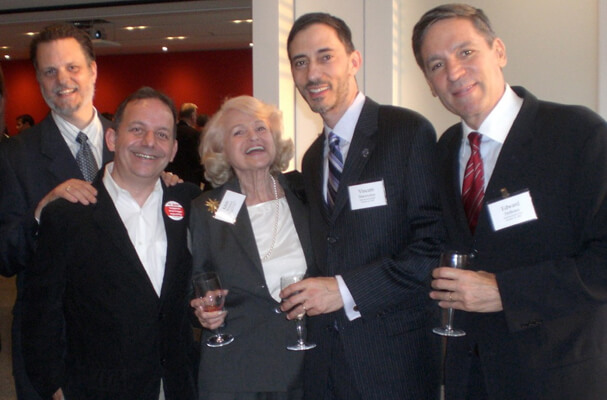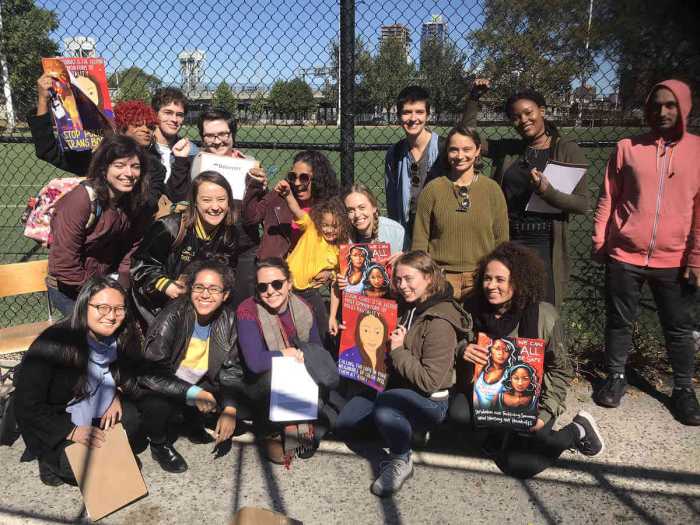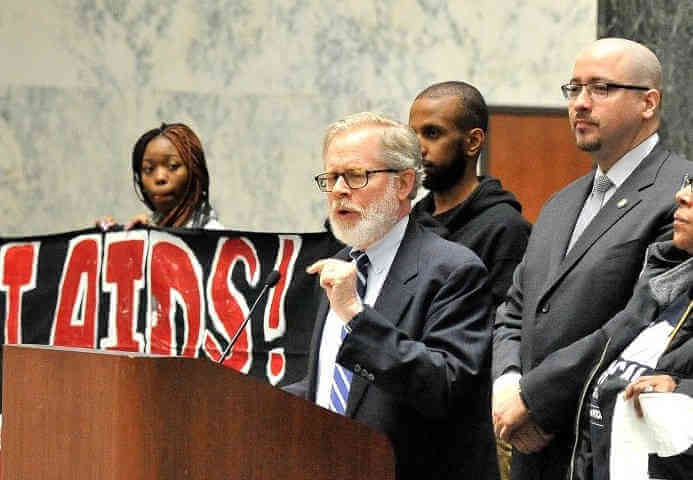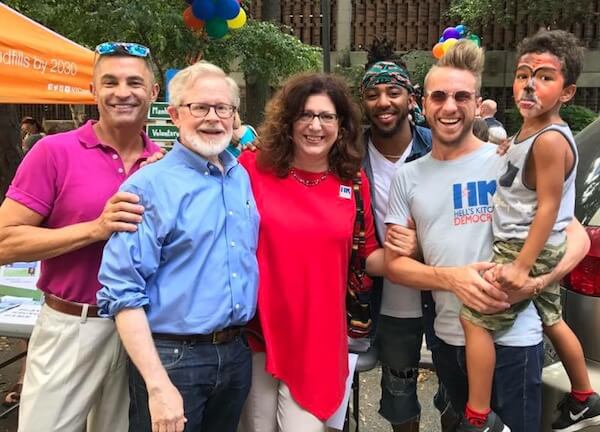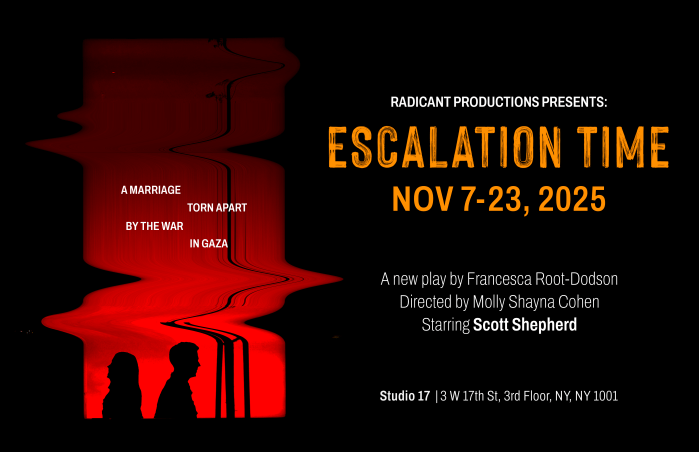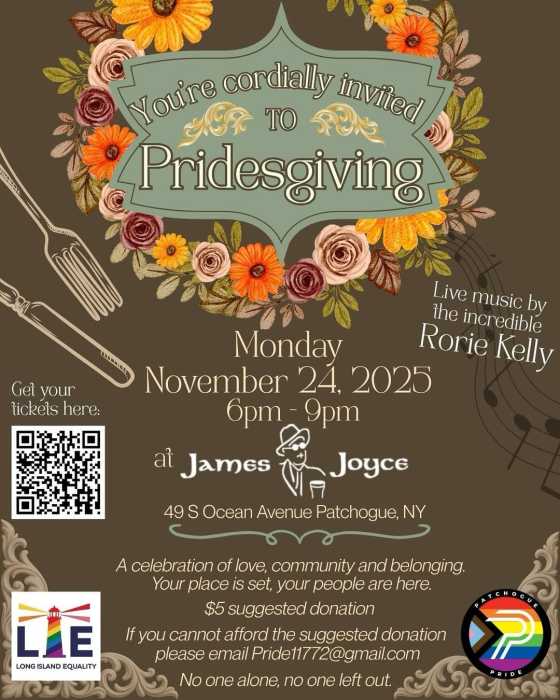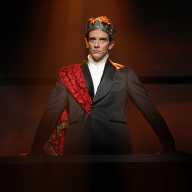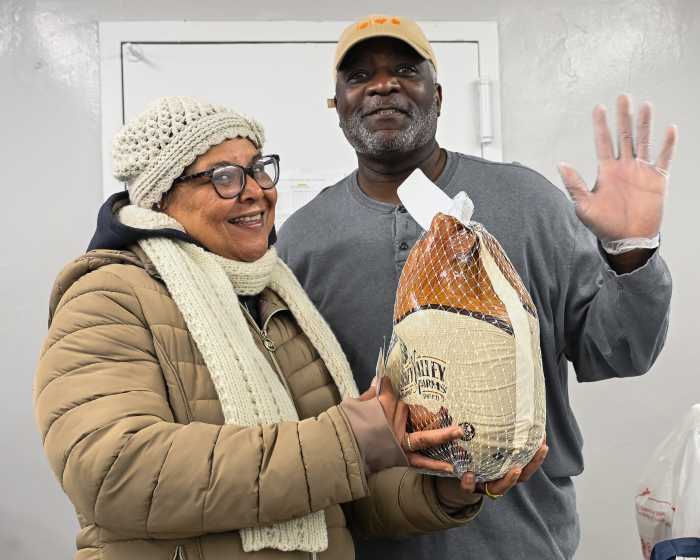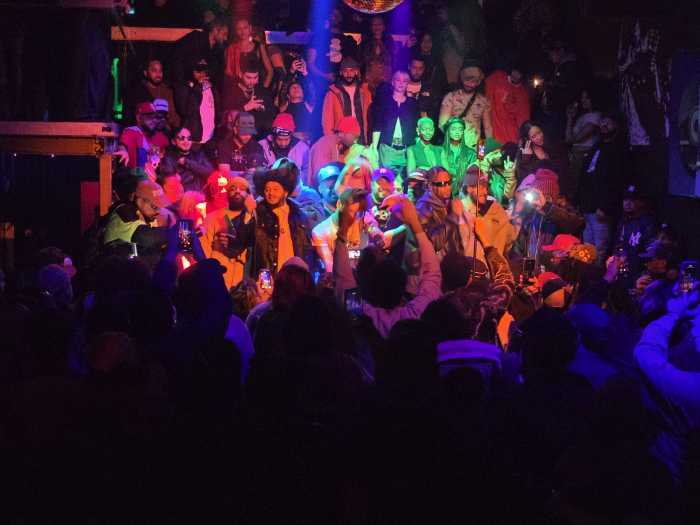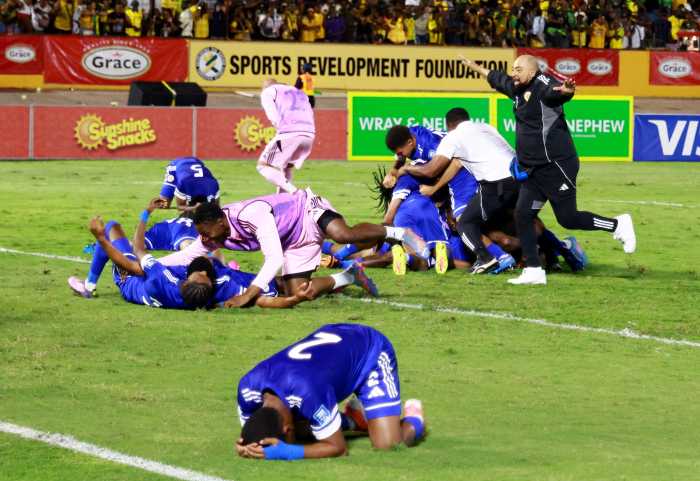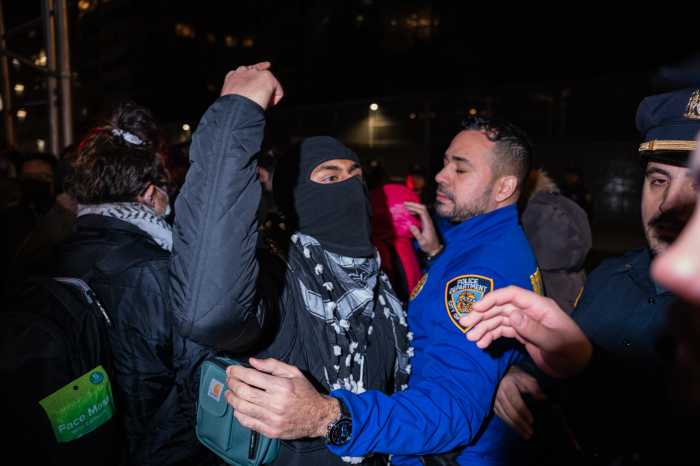Edie Windsor with (l. to r.) Tom Moulton and husband Brendan Fay and Vinnie Maniscalco and husband Ed DeBonis. | COURTESY: BRENDAN FAY
On the day she vanquished the Defense of Marriage Act, Edie Windsor, 84, deservedly took international center stage with her attorneys Roberta Kaplan, James Esseks of the American Civil Liberties Union, and Donna Lieberman of the New York Civil Liberties Union — but in a tiny side room at the LGBT Community Center where the press was barely able to squeeze in. Many of the volunteer grassroots veterans of the long fight for marriage equality going back to the 1980s were relegated to watching NY-1’s live coverage of the event projected on a screen on the Center’s third floor. Still, nothing could diminish their joy at this long and hard fought victory they championed for years when most major LGBT advocacy groups wanted nothing to do with the issue of marriage.
Gay City News caught up with these pioneers at the Center celebration, the Pride Parade four days later, and via phone and email.
Brendan Fay was at the Center, recalling how Windsor phoned him in 2007 and asked, “Are you the person who helps people get married?” Windsor’s longtime partner, Thea Spyer, was in poor health and the couple wanted to move quickly. Fay had organized a group called the Civil Marriage Trail to facilitate same-sex couples from New York traveling to Canada to marry, often presided over by out gay Judge Harvey Brownstone in Toronto.
Grassroots activists remember when very few supported the push for full equality
Vincent Maniscalco and Edward DeBonis, whose quest for a Catholic wedding was made into the 2004 documentary “Saints and Sinners,” were also at the Center on June 26, Maniscalco recalling the early days of the Civil Marriage Trail in 2003. “Not everyone was on board with the issue in those days,” he said.
And Cathy and Sheila Marino-Thomas, stalwarts of the grassroots groups Marriage Equality New York and later Marriage Equality USA, were also there, all smiles. Speaking by phone days later, Cathy said, “After years of working toward it and it seeming as if it would never happen, when it did it felt really fast. I thought of all the years of frustration, but it didn’t seem as long as when I was in it.”
Cathy got involved in Marriage Equality — founded in 1997 by activists Jesús Lebron, Connie Ress, and James Loney, among others — two years later, “because Sheila wanted to have a kid and it bothered me that we wouldn’t have legal protection. I met Michael Sabatino [now a Yonkers city councilman] and Robert Voorhies, and that was that.”
Fay credited Lebron with “suggesting we needed to take the action of ACT UP and address the issue of marriage” after DOMA was passed with the support of 80 percent of the Congress and signed by President Bill Clinton. “We were shocked that elected officials were debating the integrity and legitimacy of our relationships,” he said.
On Pride Day, Fay said, he was mindful of politicians who led the way but also recalled those who stood in the way. Despite the fact that DOMA’s demise will end the hurdles facing binational same-sex couples, he remained stung that Senate Democrats had earlier this year ducked resolving that issue in their immigration reform efforts.
“I challenged Chuck Schumer and said I was appalled and outraged at what he did to the community in the immigration reform bill,” he said. “His staffer said, ‘It’s a happy day, so be happy,’ and I said, ‘It is a happy day because of years of activists and no thanks to you.’ One of my first demonstrations was outside Schumer’s residence after he voted for DOMA. He never apologized for that. I went up to Dick Gottfried in the parade and thanked him” for being the original sponsor of the marriage equality bill in the State Assembly.
Lebron, who turned the phrase “marriage equality” into an organization in 1997, wrote in an email that “despite the fervent ignorance of many of our adversaries, good will, determination, and hard work can often result in vindication and victory.” He also wrote, “Marriage inequality is painful and vile, and its my hope that the other two thirds of our population are celebrating sooner than later their right to live freely and openly as families protected and served justly by the constitutional right to marry.”
Much of the activism that led up to marriage equality began much earlier in New York with the fight for domestic partner recognition. The Village Voice was the first company in the country to extend such benefits to its employees in 1982. Lambda Legal sued the city on behalf of gay teachers to win partner benefits for municipal employees, a suit that took six years and wasn’t settled until 1993 by Mayor David Dinkins on the eve of his loss to Rudy Giuliani. Dinkins had earlier established a domestic partner registry helpful to couples trying to prove their relationship status in order to obtain private sector benefits. Dinkins’ predecessor, Ed Koch, had extended bereavement leave to gay partners in 1989, again on the eve of an election defeat — in the Democratic primary.
Ron Madson and his husband Richard Dietz of Brooklyn Heights were plaintiffs in the teachers’ suit along with Ruth Berman and her wife Connie Kurtz, who now live in Florida where they are agitating for marriage equality.
Madson recalled that when the Stonewall Riots occurred, he was working in the Village for his lesbian aunt. “Fast forward to now and here we are with federal recognition,” he wrote in an email. “I look back at those 44 years. It seems unbelievable and yet real. I always say we stand on the shoulders of giants. Every voice raised for justice, every jailed loiterer, every person who lost a job or family, every suicide, every friend who suffered and died of AIDS, Harvey Milk, the death of Matthew Shepard, etc. created this accomplishment. Anita Bryant and Proposition 8 created this. The determination of the LGBT community comes out of the realization that we are in a genocidal struggle. We were not given anything. We struggled, fought, pledged our fortunes, and died for this right.”
It was their friend Gene’s death from AIDS that propelled Madson and Dietz to enter the suit for domestic partnership. “You know, we always considered it second class, but it was a step in the right direction,” Madson said. He noted their benefits have been taxed for almost 20 years, even after their 2008 marriage.
Dietz said the June breakthrough made him recall the bad old days “when we had to hide,” writing, “I never in my life expected to be married — and it does make a difference in the way you relate to each other and to the world around you. Now we tell car rental clerks that we are married and check the married box on forms without fear or embarrassment. It seems like it has happened rapidly, but it’s been decades in the making… We are fortunate to live in this great country, unlike other primitive places where we are imprisoned or burned to death for who we are. Those are the real heroes whose very lives are at stake every day. Hooray for the USA.”
Tom Smith, with whom I worked in the Coalition for Lesbian and Gay Rights (CLGR) that got the city’s gay rights law enacted in 1986, recalled how after that fight the focus turned to partner recognition. “
“We met with [Village] Assembly Member Bill Passanante [the chief sponsor of the state gay rights bill from its genesis in the early 1970s] in 1987 when we asked him to introduce a Marriage Bill,” Smith wrote in an email. Passanante “told us he couldn’t do it because he would be the laughing stock of the Assembly.” When Passanante decided not to seek reelection in 1990, out lesbian Deborah Glick replaced him.
Smith recalled that under Saul Fishman’s leadership, CLGR’s Family Diversity Coalition worked with Congresswoman Carolyn Maloney, who was then on the City Council, to introduce domestic partnership legislation against the will of Peter Vallone, Sr., who then led the Council.
In an email, Fishman wrote, “Speaker Vallone said the bill was ‘doomed,’ claiming that the bill was pre-empted by state law. New York Law School Professor Art Leonard [Gay City News’ legal correspondent], a member of the Family Diversity Coalition, countered with a great brief demonstrating that this bill did not in any way contradict state law.”
Fishman said he was “absolutely delighted” with the Supreme Court victory. “It is the logical conclusion of what we were working on then,” he said. “We always saw it as the end goal, but we knew it wasn’t attainable so we wanted to develop a mechanism by which the government could recognize our relationships.”
He recalled the “big crowds” that turned up for meetings at the Community Center in the 1980s and into the ‘90s — several hundred on June 27, 1989, the anniversary of Stonewall, to rally for domestic partner legislation and 500 for a strategy meeting in 1990 chaired by Glick, CLGR’s Eleanor Cooper, and Tom Duane, who last year retired from the State Senate. Fishman noted that the late gay disabled activist Harry Wieder was instrumental in getting the disability community involved in the fight for a broad-based partnership law, since many disabled folks avoid marrying out of concern over losing benefits eligibility.
Fishman and his domestic partner who came to the US from China have “been contemplating marriage and [when we do] I can sponsor him for a green card.” He added, “It's a pity that it took a full generation, more than 25 years, from when we first started fighting on this issue for our full and equal rights to be realized.”

